| PRINTMAKING TECHNIQUES |
 |
| Printmaking is an art practice that has been around since the first century. Broadly defined, it is the act of transferring ink through a screen or plate - called a "matrix" - onto paper or another substrate. Within the style various categories and techniques have developed, that differ in execution and presentation, but certain aspects permeated the genre.
As an art, printmaking does not extend to the reproduction of original artworks in other mediums. Rather, it term refers to any number of techniques that allow for multiple reproductions of the same image to be created, but due to the process, each "impression" will vary slightly from the others. Because of this, the impressions are originals, not copies. Often a limited number of impressions - called an "edition" - will be created from each plate, after which time the plate is destroyed to guarantee the exclusivity of the edition.
Each printmaking technique gives the resulting impressions unique qualities. The article below outlines the different printmaking methods including materials used and the final result.
|
SUMMARY
| TECHNIQUE |
CATEGORY |
ORIGIN |
ARTISTS |
| Lithography |
Planographic |
Invented in Germany in 1796 by Alois Senefelder. |
Honoré Daumier, Robert Rauschenberg, Jasper Johns |
| Engraving |
Intaglio |
Engraving has been practised since the Stone Age. The late 1400s to the mid 1500s is considered the greatest period in engraving history. |
Albrecht Dürer, Rembrandt, Francisco de Goya |
| Etching |
Intaglio |
As it applies to printmaking, the technique is thought to have originated in Germany around the turn of the 16th century. |
Edward Hopper, Pablo Picasso, Otto Dix |
| Mezzotint |
Intaglio |
Developed around the same time as the aquatint, by German artist Ludwig von Siegen. |
Peter Ilsted, Ludwig von Siegen, M.C.Escher |
| Monotype |
Planographic |
The process was invented by Italian painter Giovanni Benedetto Castiglione in the 17th century. |
Paul Klee, Edgar Degas |
| Screenprint |
Stencil |
First used in China during the Song Dynasty (10th - 13th century) |
Andy Warhol, Roy Lichtenstein |
| Woodcut |
Relief |
Oldest known images created in Asia around the 1st century. |
Ancient Asian artists, Ernst Ludwig Kirchner, Edvard Munch |
|
| PRINTMAKING CATEGORIES
|
 |
RELIEF
Relief printmaking involved applying ink to a rigid matrix that has been carved or etched with the intended design. The ink is placed on the raised portions of the carving; when the matrix is pressed to the paper, the raised portions will show, and the recesses will remain the color of the paper.
Techniques:
- Wood cut (also called wood blocks
- Wood engraving
- Linocut
- Metal cut
- Collagraphy
- Viscosity printing
INTAGLIO
Intaglio is essentially the reverse of Relief printmaking. Again, a design is created on a rigid matrix, but the ink is poured over the entire surface and then wiped from the raised portions, leaving ink only in the recesses. As a result, the raised portions will remain white, while the recesses will appear on the paper.
Techniques:
- Engraving
- Etching
- Mezzotint
- Aquatint
- Collagraphy
- Viscosity printing
PLANOGRAPHIC
In this procedure, a layer of wax or oil is spread on the rigid surface of the matrix. The image is carved into the wax, and then the matrix is placed in an acid solution that eats away at the area no longer protected by the wax. Afterwards, the wax is scraped off, so the image remains inscribed in the surface like an intaglio print.
Techniques:
- Lithograph
- Monotype
- Digital processes
STENCIL
In stencilled printmaking, a screen made from silk or another type of fabric is prepared with the image. The holes in the fiber of the fabric are blocked where the image is not wanted. Ink is then pressed through the screen matrix and deposited onto the paper below.
Techniques;
- Screenprint (also called silk screen)
- Pochoir
DIGITAL PRINTMAKING
Using a printer instead of a traditional press, images can be printed on many substrates, including paper, canvas, plastics, and rigid materials. A high resolution digital file is required to create a quality digital print, and the technician must use color profiles specific to the printer, ink, and substrate to ensure the printed color matches the original intention of the artist.
Giclée digital prints are created using ink jet printers with up to 12 ink that are mixed to create thousands of colors. Generally these inks follow the CMYK color mode: cyan, magenta, yellow and black. Additional inks include light cyan, light magenta, and various black densities.
FOIL IMAGING
A relatively new style of printmaking that was first practised in the late 1980s, foil imaging involves using a heat press to apply roll-leaf, "hot stamped" foil to various surfaces to create iridescent, reflective images. Some artists combine traditional printmaking methods with foil imaging in their pieces.
|
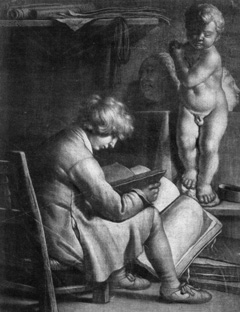
Mezzotint, Vaillerant, 1600s
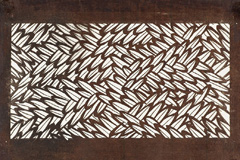
Printmaking stencil for fabric
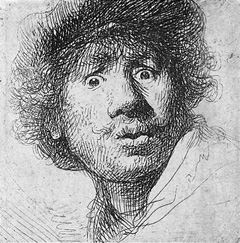
Etching, Rembrandt, 1630
|
| PRINTMAKING TECHNIQUES
|
 |
COLLAGRAPHY
Collagraphy uses various materials glued to rigid wood or paperboard to create a surface with many diverse textures. Ink is applied to this surface and pressed onto the paper to create the print. Both relief and intaglio versions are practised.
LITHOGRAPHY
Invented in 1798, lithography captures very fine tonal variations (shading) and small details. the desired image is drawn on a rigid surface - usually limestone - with grease pencil. Acid is applied to burn the image into the stone, and another substance seals the sections not drawn. When water is added, it beads on the seals section and avoids the drawn area. A roller applies oil-based ink, which sticks to the drawn area alone (because water repels oil). A piece of paper is then laid over the stone, and the ink is transferred using a printing press.
ENGRAVING
Developed in Germany in the 15th century, engraving was originally used to decorate metals in jewelry making. A tool of hardened steel is used to carve an image into a metal surface - usually copper. Different tools (burn, roulette, rocker, burnisher) create different types of markings, which allows the artist to achieve very fine gradations of shading and texture. The finished matrix is covered with ink, and the raised portions are wiped clean. When the paper is pressed into the surface, the recessed sections transfer ink to create the print.
DRYPOINT
A type of engraving, drypoint matrices are created using a sharp point instead of a v-shaped "burin". The scratching of the tool leaves rough edges on the engraved markings, which results in a print with soft or even blurry lines. The pressure of the printing press flattens these rough edges quickly, so most drypoint matrixes are used only for small print runs.
ETCHING
Another intaglio method of printmaking is etching. Where engraving is a difficult skill that requires knowledge of metalworking, etching was seen as simpler to learn, and could be mastered by artists skilled in drawing. To create the matrix, a metal plate is covered in wax or another substance and the image is drawn with an etching needle. The entire piece is then placed in an acid bath, where the exposed metal areas are eaten away. The wax is then scraped from the surface, and ink is applied in the recesses created by the acid.
MEZZOTINT
A mezzotint is a form of engraving that uses gradations of light and shade to create an image. A copper plate is roughened evenly with a rocker, and the image is formed using a burnisher to smooth areas of the surface to varying degrees. The rougher areas hold more ink than the smooth areas, so when the paper is pressed to the matrix, many different densities of the ink color are achieved.
AQUATINT
Aquatinting uses acid to remove an image from an etched metal plate. It differs from simple etching in that a powdered substance called rosin is added to the substance into which the image is carved. The rosin is baked to set it on the matrix, and can then be scratched or burnished away to create tonal variations on the surface. Acid exposure is varied to affect separate sections differently.
MONOPRINT
Monoprints use woodblocks, lithostones, or metal plates to create a single image, but each printed impressions is different and unique. This is achieved by using different colors, types, or thicknesses of ink for each print.
MONOTYPE
An image is painted or drawn onto a smooth, non-absorbent surface such as copper, zinc, or acrylic glass. The image is then transferred to paper by pressing the two surfaces together. Subtractive images can also be made by covering the matrix surface with ink and removing it in certain areas. Most of the ink is removed from the matrix on the first print; if any ink remains, subsequent prints appear as very faded versions of the first, and are called "ghost prints". Monotyping is primarily a conceptual art form which allows the artist to create an original painting or drawing using printmaking methods.
SCREENPRINTING
Screenprinting, or silk screening, uses a fabric stencil through which ink is pressed or brushed onto the paper below. The mesh fabric used is stretched into a wooden frame, and the image is created by blocking certain areas so ink cannot pass through them. The open areas will be replicated on the paper. A different screen is created for each color, which can be laid over the previous color.
Unlike most other techniques, no printing press is used for this printmaking method. Due to time consuming preparation, screenprinting is often reserved for large print runs.
Pochoir uses stencils as well. Unique, limited edition prints are created because the space within the stencil is painted by hand. The technique is also known as "hand coloring" or "hand illustration".
WOODCUT
The earliest known printmaking technique, wood cuts are first known to be used in Asia and often for patterns printed on fabrics, or for replicating text. A design is drawn onto a wood surface, and various sharp tools are used to carve away the areas around the image. Ink is applied to the raised sections using a "brayer", so the print remains uncolored in the carved areas. Different carvings may be used to add colored sections to the image. "Woodcut" refers to both the matrix and the print.
The Linocut technique is the same as woodcut, but the artist carves into linoleum instead of wood. The lack of wood grain creates a different texture in the print.
VISCOSITY PRINTING
By creating inks with various viscosities, multiple colors can be placed on the matrix at one time. These colors can be layered on top of one another (their varying viscosities mean they will not mix) or separate colors can be applied to the raised and recessed sections of the matrix. This technique is time consuming and rarely used in large print runs. Because of the delicacy of the ink application, each impression often differs greatly from the others.
|
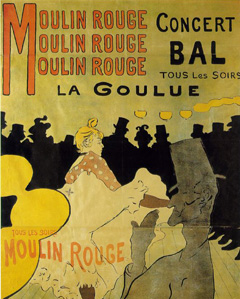
Lithograph, Toulouse-Lautrec, 1890
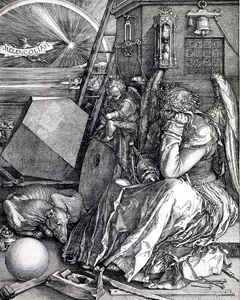
Engraving, Albrecht Dürer, 1514
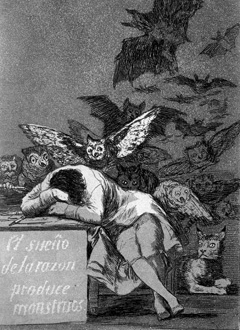
Aquatint Etching, Francisco Goya, 1797
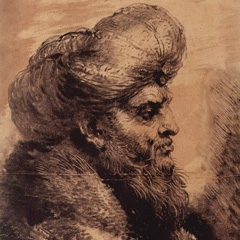
Monotype, Castiglione, 1654
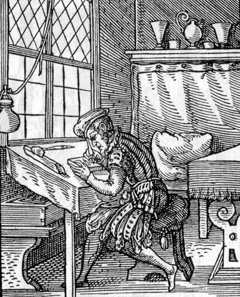
Woodcut, Jost Amman, 1568
|
| This article was written with assistance from Wikipedia's Printmaking entry.
|
|
© 2002-2026 - KeenART Media Ltd.
|
|
| |
|

